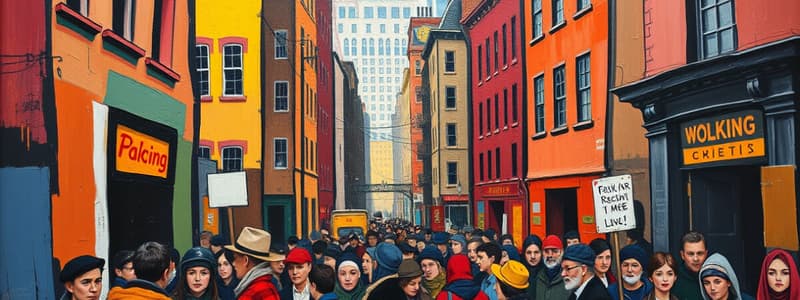Podcast
Questions and Answers
Which of the following would not have been the job of a poor working-class woman?
Which of the following would not have been the job of a poor working-class woman?
- Domestic servant
- Factory worker
- Typist (correct)
- Seamstress
A large apartment building that was overly crowded and loud and dirty was called what?
A large apartment building that was overly crowded and loud and dirty was called what?
a tenement
Why were some people unwilling to give money to charity?
Why were some people unwilling to give money to charity?
They thought the poor didn't want to improve their condition
Why did people stay in the tenements?
Why did people stay in the tenements?
The rules to move into a model tenement were very strict. Which would not have been one of those rules?
The rules to move into a model tenement were very strict. Which would not have been one of those rules?
What were areas in a city called where most of the poor working class lived in crowded conditions?
What were areas in a city called where most of the poor working class lived in crowded conditions?
Which of these was a job that a working-class man would most likely hold?
Which of these was a job that a working-class man would most likely hold?
How did people in tenements get clothing?
How did people in tenements get clothing?
Many working-class families lived in slums because:
Many working-class families lived in slums because:
What kinds of jobs did working-class women hold?
What kinds of jobs did working-class women hold?
What happened in the tenements because landlords charged high rent?
What happened in the tenements because landlords charged high rent?
The term working class was used to describe which group of people?
The term working class was used to describe which group of people?
Flashcards are hidden until you start studying
Study Notes
Working-Class Women
- Typists were not typically jobs for poor working-class women.
- Working-class women often engaged in roles such as seamstresses.
Tenement Living
- A tenement is a large, overcrowded apartment building characterized by noisy and unsanitary conditions.
- Families remained in tenements largely due to financial constraints, unable to afford better living conditions.
- As landlords increased rent, tenements became increasingly crowded, contributing to poor living conditions.
Charity and Perceptions of Poverty
- Some individuals refrained from donating to charity due to the belief that the poor lacked motivation to improve their circumstances.
- Many working-class families resorted to living in slums because they could not afford alternative housing.
Community and Employment
- Areas within cities where the poor working class resided were often referred to as slums.
- Working-class men were more likely to hold jobs in industries that were low-paid, reflecting the economic challenges of the time.
Clothing and Resources
- Many tenement residents crafted their own clothing due to limited financial resources, relying on personal skills instead of retail.
- The term "working class" refers to low-paid workers and their families, who formed a significant part of the urban population.
Studying That Suits You
Use AI to generate personalized quizzes and flashcards to suit your learning preferences.




